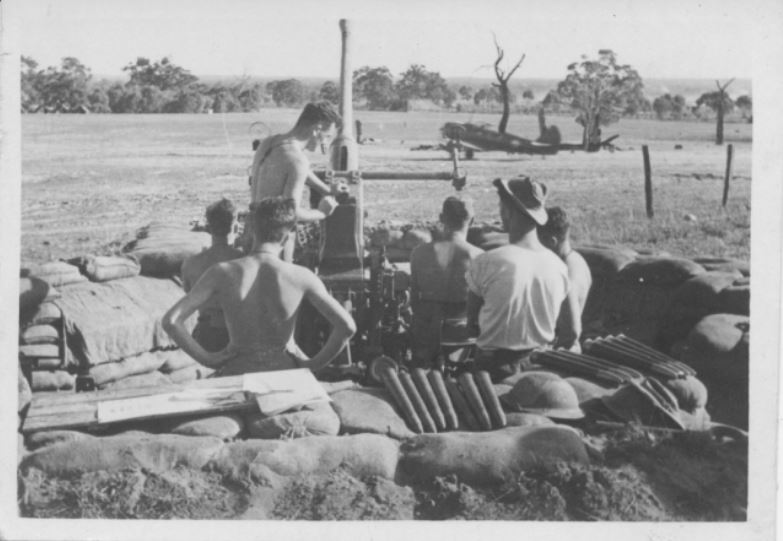No. 85 Squadron RAAF
From Our Contribution
 AA Gun crew at Dunreath | |
Brief History
On 23 February 1943, Squadron Leader C.N. Daly was directed to form No. 85 Squadron at Guildford, Western Australia. It was to be located at Dunreath Aerodrome [1]. Flying commenced with Brewster Buffalos and approximately 140 hours were flown on these aircraft before the first 11 CAC Boomerangs arrived on 30 April, having flown from No. 83 Squadron at Strathpine, Queensland. On reaching Dunreath they were informed that they would be moving to 'Potshot', Exmouth Gulf, to form half a squadron there. At 'Potshot' the aircraft landed on a dusty strip parallel to the coast and close to the United States Navy base on the shore-line. All personnel were billeted in a Nissen hut at the base until Masonite huts were completed in May 1943 between the airstrip and the coast.
On 20 May 1943, No. 6 Fighter Sector reported that unidentified aircraft were approaching. Two Boomerangs took of to find them without success. During the evening of the 21st, three unidentified aircraft flew over the airstrip. Again two Boomerangs took of to intercept but again the aircraft evaded the defenders.
Training exercises began in earnest, the planes being operated from the new bitumen strips. After becoming familiar with the area the pilots carried out formation and gunnery exercises, security patrols, cooperation with the anti-aircraft batteries and night flying. On 15 Sep 1943 there was a yellow warning at 2330 hours. Four aircraft were airborne for two hours but there were no sightings. Training exercises for the rest of the Squadron at Guildford took place before there was a fatal accident at Guildford due to an aircraft swinging on take-off. The aircraft burnt and the pilot died in hospital six days later. On 30 Sep 1943 a signal was received on 30 Sep 1943 to move Boomerang aircraft to Derby for an emergency operation. On 3 October 1943 a fatal accident occurred at Derby when a pilot was detailed to locate and drop a message to the SS Koomilya in King Sound. After doing so, the aircraft rolled and plunged into the Sound. Meanwhile at Guildford there were two fatal accidents in a fortnight.
In January 1944 the last of the Buffalo aircraft was flown to Eagle Farm by the Commanding Officer. During July 1944, the Squadron began gearing up to fly Supermarine Spitfires, and during September 1944 the first of the 25 Spitfires arrived. In the meantime the Squadron an several occasions sent aircraft to Derby to conduct patrols of the Kimberley coast. On 12 January 1945. the Commanding Officer led a flight of 12 Spitfires in a Squadron formation. The last of the Boomerangs left Guildford for Kalgoorlie, the Squadron now being fully equipped with Spitfires.
On 11 May 1945 the Squadron received instructions that 1t was to move to Pearce airfield. Flying resumed at Pearce and cross country nights were made to Cunderdin and Kalgoorlie. On 7 July, the Squadron had the sad task of escorting the aircraft carrying the remains of the late Prime Minister, John Curtin. Flying officially ceased on 20 September and the Squadron officially ceased to function on the 24th. Aircraft were allotted to 6 Aircraft Depot. On 11 October it was announced that 29 Nov 1945 would be the last day of No. 85 Squadron. From the 20th onwards disbandment proceeded and offices, tool stores and maintenance shops were all vacated.
Ground Crew
- Stewart Chandler Mack 11 May- 23 Dec 1943
- Joseph Butler Boyd 10 Apr - 7 Sep 1944
- Alfred William Walker 13 Jun - 30 Oct 1944
- Mervyn James Pound 4 Jun - 3 Oct 1945
- William Albert Beattie 10 Apr - 12 Jul 1944
Notes
In early 1942, the area on which Perth Airport is now located was converted from the Dunreath golf course to an RAAF base, which operated until the end of World War II in 1945.
Content has come from Units of the Royal Australian Air Force - A Concise History - Volume 2 Fighter Units - Australian Government Publishing Service - 1995 pages 87 - 91
- Jump up ↑ In early 1942, the area on which Perth Airport is now located was converted from the Dunreath golf course to an RAAF base, which operated until the end of World War II in 1945